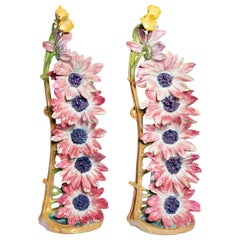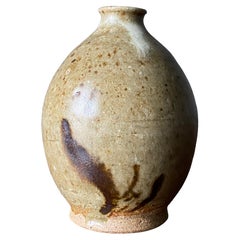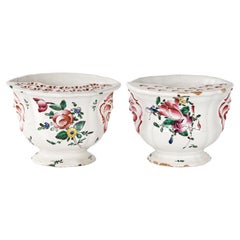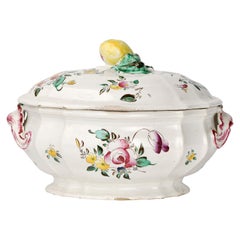Antonio Ferretti Ceramics
9
to
9
9
9
9
7
2
9
9
9
9
9
9
8
385
264
186
120
Creator: Antonio Ferretti
Ancient Italian Assortment Coffe Pot and Cups, Lodi, Circa 1765-1770
By Antonio Ferretti
Located in Milano, IT
A coffee pot and two cups with saucers
Antonio Ferretti Manufacture
Lodi, Circa 1765-1770
Maiolica polychrome decorated “a piccolo fuoco” (third fire).
They measure:
coffee pot: 9....
Category
1760s Italian Rococo Antique Antonio Ferretti Ceramics
Materials
Maiolica
Italian Maiolica Cup Ferretti Lodi, circa 1770 - 1780
By Antonio Ferretti
Located in Milano, IT
Maiolica puerperal cup
Antonio Ferretti Manufacture
Lodi, Circa 1770 - 1780
Maiolica polychrome decorated “a piccolo fuoco” (third fire).
It measures: 4.3 x 6.8 x 5.3 in (11 x 17,5 x 13,5 cm)
Weight: 0.78 lb (358 g)
State of conservation: some closed pass-through fêlures on the cup, barely visible on the outside. Some use chips on the edge of the lid, two of which are more marked.
From about the mid-sixteenth century, the puerperal soup tureen or puerperal cup became one of the most popular wedding gifts in central Italy. As an auspicious symbol, it replaced the birth table (“desco da parto”) which, on the occasion of high-ranking marriages, from the thirteenth century, had been painted by famous artists, especially in Tuscany.
In France this same tureen is called "écuelle de mariée", as it is given to spouses as a sign of fertility.
During the eighteenth century this custom spread even outside Italy to all social levels. Depending on availability and rank, it was made of different materials: precious metals, maiolica, porcelain, glass, pewter, etc.
Beginning in the mid-twentieth century, the custom of this symbolic homage gradually disappeared, although famous designers such as Gio Ponti and Giuseppe Gariboldi, even as recently as the 1940s, revisited a model of a small puerperal soup bowl for the Ginori and, also in Italy in 1940, in a national competition for young potters, one of the themes of the test was indeed a modern model of a puerperal cup as an auspicious gift.
This particular cup was also called a "service cup" or "puerperal vase" or "stuffed cup" - the windows were sealed with straw to prevent drafts of air for women in labor.
In the eighteenth century the line of the puerpera cup was simplified, so much so that it took the form of a small tureen with two handles - the typical broth cup...
Category
1770s Italian Rococo Antique Antonio Ferretti Ceramics
Materials
Maiolica
Small Maiolica Flower Pots, Ferretti Manufacture, Lodi, circa 1770-1780
By Antonio Ferretti
Located in Milano, IT
Two maiolica flower pots
Antonio Ferretti Manufacture
Lodi, Circa 1770 - 1780
Maiolica polychrome decorated “a piccolo fuoco” (third fire)
The...
Category
1770s Italian Rococo Antique Antonio Ferretti Ceramics
Materials
Maiolica
Italian Maiolica Ancient Sugar Bowl, Lodi, 1770-1780
By Antonio Ferretti
Located in Milano, IT
Maiolica sugar bowl
Antonio Ferretti Manufacture
Lodi, Circa 1770-1780
Maiolica polychrome decorated “a piccolo fuoco” (third fire).
It measures 3.54 x 4.52 x 3.54 in (9 x 11,5 x 9 cm)
Weight: 0.394 lb (0.179 kg)
State of conservation: small and slight chips on the edges.
The small sugar bowl has a swollen and ribbed body resting on a flat base. The cap-shaped lid follows the rib of the container and is topped with a small knob in the shape of a two-colored fruit.
The sugar bowl is painted “a piccolo fuoco” (third fire) with the characteristic floral motif of bunches and isolated semis.
An example which closely corresponds to this one is kept at the Civic Museum in Lodi (G. Gregorietti, Maioliche di Lodi, Milano e Pavia, Catalogo della Mostra, Milano, 1964 n. 137).
This decorative style represented a strong point of the Lodi factory, which established itself thanks to the vivid nature of the colors made possible by the introduction of a new technique perfected by Paul Hannong in Strasbourg and later introduced by Antonio Ferretti to Italy. The production process, called “piccolo fuoco” (third fire), allowed the use of a greater number of colors than in the past; in particular, the purple of Cassius, a red made from gold chloride, was introduced. Its use allowed for many more tones and shades, from pink to purple.
The Ferretti family started their maiolica manufacturing business in Lodi in 1725.
The forefather Simpliciano started the business by purchasing an ancient furnace in 1725 and, indeed, we have evidence of the full activity of the furnaces starting from April of the same year (Novasconi-Ferrari-Corvi, 1964, p. 26 n. 4). Simpliciano started a production of excellence also thanks to the ownership of clay quarries in Stradella, not far from Pavia. The production was so successful that in 1726 a decree of the Turin Chamber came to prohibit the importation of foreign ceramics, especially from Lodi, to protect internal production (G. Lise, La ceramica a Lodi, Lodi 1981, p. 59).
In its initial stages, the manufacture produced maolicas painted with the “a gran fuoco” (double fire) technique, often in turquoise monochrome, with ornamentation derived from compositional modules in vogue in Rouen in France. This was also thanks to the collaboration of painters like Giorgio Giacinto Rossetti, who placed his name on the best specimens next to the initials of the factory.
In 1748 Simpliciano made his will (Gelmini, 1995, p. 30) appointing his son Giuseppe Antonio (known as Antonio) as universal heir. After 1750, when Simpliciano passed away, Antonio was directly involved in the maiolica factory, increasing its fortunes and achieving a reputation on a European level. Particularly important was the aforementioned introduction in 1760 of the innovative “a piccolo fuoco” (third fire) processing, which, expanding the ornamental repertoire with Saxon-inspired floral themes, was able to commercially compete with the German porcelains that had one of its most renowned offerings in the naturalistic Deutsche Blumen. Antonio Ferretti understood and promoted this technique and this decoration, proposing it in a fresher and more corrective version, less linked to botanical tables, both with or without contour lines, as well as in purple or green monochrome. After efforts to introduce more industrial production techniques to the sector succeeded, even the Ferretti manufacture, in the last decade of the eighteenth century, started heading towards decline despite its attempts to adapt production to neoclassical tastes.
In 1796 the Napoleonic battle for the conquest of the Lodi bridge over the Adda definitively compromised the furnaces. Production resumed, albeit in a rather stunted manner, until Antonio's death on 29 December 1810. (M. L. Gelmini, pp. 28-30, 38, 43 sgg., 130-136 (for Simpliciano); pp. 31 sgg., 45-47, 142-192 (for Antonio).
Bibliography
G. Gregorietti, Maioliche di Lodi Milano e Pavia Catalogo della Mostra, Milano, 1964 n. 137;
C. Baroni, Storia delle ceramiche nel Lodigiano, in Archivio storico per la città e i comuni del circondario e della diocesi di Lodi, XXXIV (1915), pp. 118, 124, 142; XXXV (1916), pp. 5-8;
C. Baroni, La maiolica antica di Lodi, in Archivio storico lombardo, LVIII (1931), pp. 453-455;
L. Ciboldi, La maiolica lodigiana, in Archivio storico lodigiano, LXXX (1953), pp. 25 sgg.;
S. Levy, Maioliche settecentesche lombarde e venete, Milano 1962, pp. 17 sgg.;
A. Novasconi - S. Ferrari - S. Corvi, La ceramica lodigiana, Lodi 1964, ad Indicem; Maioliche di Lodi, Milano e Pavia (catal.), Milano 1964, p. 17;
O. Ferrari - G. Scavizzi, Maioliche italiane del Seicento e del Settecento, Milano 1965, pp. 26 sgg.;
G. C. Sciolla, Lodi. Museo civico, Bologna 1977, pp. 69-85 passim; G. Lise, La ceramica a Lodi, Lodi 1981;
M. Vitali, in Storia dell'arte ceramica...
Category
1770s Italian Rococo Antique Antonio Ferretti Ceramics
Materials
Maiolica
Maiolica Italian Pitcher Ferretti Manufacture, Lodi Circa 1770 - 1780
By Antonio Ferretti
Located in Milano, IT
Maiolica pitcher
Antonio Ferretti Manufacture
Lodi, circa 1770-1780
Maiolica polychrome decorated “a piccolo fuoco” (third fire).
It measures 8.66 x 8.66 x 4.33 in (22 x 22 x 11 ...
Category
1770s Italian Rococo Antique Antonio Ferretti Ceramics
Materials
Maiolica
Two Pairs of Italian Maiolica Baskets, circa 1780
By Antonio Ferretti
Located in Milano, IT
Two pairs of maiolica baskets
Antonio Ferretti Manufacture
Lodi, circa 1770-1790
Maiolica polychrome decorated “a piccolo fuoco” (third fire).
Measures: A) Height 3.54 x 6.69 x 9.84 in (9 x 17 x 25 cm);
B) Height 3.93 x 7.48 x 11.02 in (10 x 19 x 28 cm).
Total weight 4.85 lb (2.200 kg)
State of conservation:
A) One of the smaller baskets has some areas of restoration, the other slight chipping from use;
B) One of the larger baskets is intact and the other shows a clearly glued break.
The mold with which the baskets were forged simulates a wicker weave.
The two larger works have high, vertical walls, with branch-shaped handles penetrating the weave. The painted decorations, small polychrome flowers applied only externally, highlight the points where the weaves intersect.
The decision to leave the center of the basket devoid of decoration is highly unusual, but given the size and complexity of the shape, as well as the quality of the enamel, it is possible to hypothesize that it represents a precise choice in manufacturing or for a particular client.
The two smaller baskets have small, twisted handles and, on the outside, reproduce more decisively the characteristic wicker weave, obtained through thin molded lines. The interior exhibits a rich, typical decoration of naturalistic flowers: a bunch centered around a main flower and secondary stems accompanied by small “semis”. The exterior of these works is also adorned with small little flowers where the weaves intersect.
The size and morphological characteristics of the baskets confirm their attribution to the Lodi factory of Antonio Ferretti between 1770 and 1790, during its most successful period; by this point his original reworking of the "Strasbourg" decoration, known as "old Lodi", had achieved great fame even outside Italy.
This decorative choice represented a strong point of the Lodi factory, which established itself thanks to the vivid nature of the colors made possible by the introduction of a new technique perfected by Paul Hannong in Strasbourg and which Antonio Ferretti introduced in Italy. This production process, called “piccolo fuoco” (third fire), allowed the use of a greater number of colors than in the past; in particular, the purple of Cassius, a red made from gold chloride, was introduced. Its use allowed for many more tones and shades, from pink to purple.
The Ferretti family had started their maiolica manufacturing business in Lodi in 1725.
The forefather Simpliciano had started the business by purchasing an ancient furnace in 1725 and, indeed, we have evidence of the full activity of the furnaces from April of the same year (Novasconi-Ferrari-Corvi, 1964, p. 26 n. 4). Simpliciano had started a production of excellence also thanks to the ownership of clay quarries in Stradella, not far from Pavia. The production was so successful that in 1726 a decree of the Turin Chamber came to prohibit the importation of foreign ceramics, especially from Lodi, to protect internal production (G. Lise, La ceramica a Lodi, Lodi 1981, p. 59).
In its initial stages, the manufacture produced maolicas painted with the “a gran fuoco” (double fire) technique, often in turquoise monochrome, with ornamentation derived from compositional modules in vogue in Rouen in France. This was also thanks to the collaboration of painters like Giorgio Giacinto Rossetti, who placed his name on the best specimens next to the initials of the factory.
In 1748 Simpliciano made his will (Gelmini, 1995, p. 30) appointing his son Giuseppe Antonio (known as Antonio) as universal heir. After 1750, when Simpliciano passed away, Antonio was directly involved in the maiolica factory, increasing its fortunes and achieving a reputation on a European level. Particularly important was the aforementioned introduction in 1760 of the innovative “a piccolo fuoco” (third fire) processing, which, expanding the ornamental repertoire with Saxon-inspired floral themes, could commercially compete with the German porcelains that had one of its most renowned offerings in the naturalistic Deutsche Blumen. Antonio Ferretti understood and promoted this technique and this decoration, proposing it in a fresher and more corrective version, less linked to botanical tables...
Category
1770s Italian Neoclassical Antique Antonio Ferretti Ceramics
Materials
Maiolica
Pair of Italian Maiolica Tureens, Ferretti Manufacture, Lodi Circa 1770 - 1780
By Antonio Ferretti
Located in Milano, IT
Pair of maiolica tureens
Antonio Ferretti Manufacture
Lodi, circa 1770-1780
Maiolica polychrome decorated “a piccolo fuoco” (third fire).
a – 8.66 x 11.02 x 7.48 in (22 x 28 x 19...
Category
1770s Italian Rococo Antique Antonio Ferretti Ceramics
Materials
Maiolica
Italian Maiolica Ancient Tureen, Lodi, 1770-1780
By Antonio Ferretti
Located in Milano, IT
Maiolica tureen
Antonio Ferretti Manufacture
Lodi, circa 1770-1780
Maiolica polychrome decorated “a piccolo fuoco” (third fire).
It measures 9.05 x 12.59 x 9.05 in (23 x 32 x 23 cm)
...
Category
1770s Italian Rococo Antique Antonio Ferretti Ceramics
Materials
Maiolica
Four Italian Ancient Dishes, Lodi, circa 1770-1780
By Antonio Ferretti
Located in Milano, IT
Assortment of 4 dishes with braided rim
Antonio Ferretti Manufacture
Lodi, circa 1770-1780
Maiolica polychrome decorated “a piccolo fuoco” (third fire).
Measures: 14 x 10 in (35.5 x 25.5 cm);
12.2 x 8.39 in (31 x 21.3 cm);
10.4 x 9.65 in (26.5 x 24.5 cm);
10.8 x 9.61 in (27.5 x 24.4 cm).
Weight: 4.4 lb (1.998 kg)
State of conservation: some chips due to use on the edges and on the parts in relief.
The four different dishes have a foot with a low lip from which extends a wide, flat, slanted rim resembling a basket weave. The small handles are painted green: they resemble wickerwork in the two oval dishes and take the form of a sinuous branch in the round ones.
The third fire decoration is inspired by the naturalistic floral botanical patterns on the ceramics produced by the Hannong family in Strasbourg. Here the pattern is defined by the rapidity and subtlety of the brushstrokes and the result is particularly tasteful, characterized by compositional intelligence and pictorial expertise.
A main corolla, either a wild or garden rose, is set slightly off center in each well. From this extends a thin stem holding a small secondary bud and there are small field florets dotting the composition to lend volume to the delicate bunch of flowers.
On the brim, small polychrome flowers add color to the weave, accompanied by lanceolate leaves of a very intense green.
There exist few and very rare examples for comparison with this morphology: a round plate - entirely consistent with those in question - has been dated to around 1775 (S. Levy, Maioliche settecentesche lombarde e venete, Milano 1962, tav. 200). Two other dishes with a basket rim, but with parallel striped brim decoration, were exhibited in the 1995 exhibition on Lodi ceramics; the attribution to the Lombard town near Milan is therefore almost exclusively derived from the decoration called "alla rosa contornata" or "alla vecchia Lodi" and constitutes one of the most popular decorations during the eighteenth century. (M. L. Gelmini, in Maioliche lodigiane del '700 (cat. mostra Lodi), Milano 1995, pp. 31 p. 162-163 nn. 181-182).
This decorative choice represented a strong point of the Lodi factory, which established itself thanks to the vivid nature of the colors made possible by the introduction of a new technique perfected by Paul Hannong in Strasbourg and which Antonio Ferretti introduced in Italy. This production process, called “piccolo fuoco” (third fire), allowed the use of a greater number of colors than in the past; in particular, the purple of Cassius, a red made from gold chloride, was introduced. Its use allowed for many more tones and shades, from pink to purple.
The Ferretti family had started their Maiolica manufacturing business in Lodi in 1725.
The forefather Simpliciano had started the business by purchasing an ancient furnace in 1725 and, indeed, we have evidence of the full activity of the furnaces from April of the same year (Novasconi-Ferrari-Corvi, 1964, p. 26 n. 4). Simpliciano had started a production of excellence also thanks to the ownership of clay quarries in Stradella, not far from Pavia. The production was so successful that in 1726 a decree of the Turin Chamber came to prohibit the importation of foreign ceramics, especially from Lodi, to protect internal production (G. Lise, La ceramica a Lodi, Lodi 1981, p. 59).
In its initial stages, the manufacture produced maolicas painted with the “a gran fuoco” (double fire) technique, often in turquoise monochrome, with ornamentation derived from compositional modules in vogue in Rouen in France. This was also thanks to the collaboration of painters like Giorgio Giacinto Rossetti, who placed his name on the best specimens next to the initials of the factory.
In 1748 Simpliciano made his will (Gelmini, 1995, p. 30) appointing his son Giuseppe Antonio (known as Antonio) as universal heir. After 1750, when Simpliciano passed away, Antonio was directly involved in the Maiolica factory, increasing its fortunes and achieving a reputation on a European level. Particularly important was the aforementioned introduction in 1760 of the innovative “a piccolo fuoco” (third fire) processing, which, expanding the ornamental repertoire with Saxon-inspired floral themes, could commercially compete with the German porcelains that had one of its most renowned offerings in the naturalistic Deutsche Blumen. Antonio Ferretti understood and promoted this technique and this decoration, proposing it in a fresher and more corrective version, less linked to botanical tables...
Category
1770s Italian Neoclassical Antique Antonio Ferretti Ceramics
Materials
Maiolica
Related Items
Pair of Glazed Ceramic Flower Vases by Delphin Massier, France, circa 1890
By Delphin Massier
Located in Buenos Aires, Buenos Aires
Pair of glazed ceramic flower vases by Delphin Massier, France, circa 1890.
Category
Late 19th Century French Art Nouveau Antique Antonio Ferretti Ceramics
Materials
Ceramic
H 29.93 in W 10.24 in D 9.06 in
Studio Pottery Weed Pot, circa 1975
Located in Costa Mesa, CA
Studio Pottery weed pot / vase. circa 1975.
Category
20th Century American Mid-Century Modern Antonio Ferretti Ceramics
Materials
Ceramic
Antique Quality Japanese Imari Bowl
Located in Suffolk, GB
Antique quality Japanese Imari bowl having a quality scalloped shaped Japanese Imari bowl with wonderful hand painted decoration in red, blue, oran...
Category
Early 20th Century Japanese Antonio Ferretti Ceramics
Materials
Ceramic
Midcentury Vintage Small Porcelain Blue Flower Vase, Europe, 1960s
Located in 05-080 Hornowek, PL
Vintage glass in very good condition. The vase looks like it has just been taken out of the box. No jags, defects etc. Only one unique piece. Porcelain glass.
.
Category
Mid-20th Century Italian Mid-Century Modern Antonio Ferretti Ceramics
Materials
Porcelain, Glass
English Victorian Parian Majolica Corn Pitcher, circa 1890
Located in Austin, TX
White English Victorian Parian Majolica Corn Pitcher, circa 1890.
Category
1890s English Victorian Antique Antonio Ferretti Ceramics
Materials
Tin
Mid Century Lidded Bowl by Ceramiche Batignani, Italy
By Ceramiche Batignani
Located in Albano Laziale, Rome/Lazio
A beautiful pumpkin shaped bowl with lid crowned by a brass handle by Ceramiche Batignani from the 1950's. This handmade bowl is in perfect condition.
Category
Mid-20th Century Italian Mid-Century Modern Antonio Ferretti Ceramics
Materials
Ceramic
Set of antique Chinese Unglazed Pots
Located in Jesteburg, DE
A set of antique unglazed pots, circa 1920.
Very impressive and decorative. Individually or as a pair they can even be
impactful staged on the floor du...
Category
Early 20th Century Chinese Antonio Ferretti Ceramics
Materials
Pottery
French Majolica Wild Rose Pitcher Fives Lille, circa 1900
By Fives-Lille
Located in Austin, TX
French Majolica wild rose pitcher fives Lille, circa 1900.
Category
Early 1900s French Art Nouveau Antique Antonio Ferretti Ceramics
Materials
Ceramic
Regency Period Derby Cup and Saucer Duo Hand Painted, Circa 1830
By Royal Crown Derby Porcelain
Located in Lincoln, Lincolnshire
This is a beautiful porcelain duo of a cup and saucer by the Derby factory, made during the late Georgian, Regency period of the first half of the 19th century, circa 1830
The han...
Category
Early 19th Century British Regency Antique Antonio Ferretti Ceramics
Materials
Porcelain
Early 1900s Italian Majolica Orciuolo Apothecary Pitcher
By Castelli
Located in Dallas, TX
From Italy, this majolica apothecary pitcher (orciuolo) is in the manner of the pitcher done by Castelli, circa 1520, housed in the MET Museum NYC,...
Category
Early 20th Century Italian Renaissance Antonio Ferretti Ceramics
Materials
Majolica
Minton Majolica Small Jardinière Flower Trough Singed, Dated 1871
By Minton
Located in Banner Elk, NC
Minton Majolica Small Jardiniere, realistically molded as a simulated water trough formed by faux wooden staves and pegs, overlain with budding Hawthrone branches, the corners formed as mossy posts, banded near the base with pegged logs, the interior glazed in Minton Blue (turquoise); impressed marks to reverse: 'MINTON,' with British Registry Number for 16 April 1870 (when the design was registered), Minton date cipher for 1871, and the Design Number, '1563,' which corresponds to the entry, 'FLOWER TROUGH...
Category
19th Century English Victorian Antique Antonio Ferretti Ceramics
Materials
Majolica
Ceramic Cup by Jacques Lenoble, circa 1940
By Jacques Lenoble
Located in Saint-Ouen, FR
A ceramic cup by Jacques Lenoble with pink glaze decoration.
Perfect original conditions.
Signed under the base,
circa 1940.
Category
20th Century French Art Deco Antonio Ferretti Ceramics
Materials
Ceramic
Previously Available Items
Pair of Italian Maiolica Flower Pots, Antonio Ferretti, Lodi, circa 1770 – 1780
By Antonio Ferretti
Located in Milano, IT
Pair of flower pots
Antonio Ferretti Manufacture
Lodi, circa 1770 – 1780
Maiolica polychrome decorated “a piccolo fuoco” (third fire)
They meas...
Category
1770s Italian Rococo Antique Antonio Ferretti Ceramics
Materials
Maiolica
H 4.73 in W 6.7 in D 5.71 in
Italian Ancient Maiolica Tureen, Lodi, 1770-1780
By Antonio Ferretti
Located in Milano, IT
Maiolica tureen
Antonio Ferretti Manufacture
Lodi, Circa 1770 - 1780
Maiolica polychrome decorated “a piccolo fuoco” (third fire).
It measures 7.48 x 7.48 x 11.02 in (19 x 19 x 2...
Category
1770s Italian Rococo Antique Antonio Ferretti Ceramics
Materials
Maiolica
Antonio Ferretti ceramics for sale on 1stDibs.
Antonio Ferretti ceramics are available for sale on 1stDibs. These distinctive items are frequently made of maiolica and are designed with extraordinary care. There are many options to choose from in our collection of Antonio Ferretti ceramics, although beige editions of this piece are particularly popular. Many of the original ceramics by Antonio Ferretti were created in the Rococo style in italy during the 18th century and earlier. If you’re looking for additional options, many customers also consider ceramics by and Pasquale Rubati. Prices for Antonio Ferretti ceramics can differ depending upon size, time period and other attributes — on 1stDibs, these items begin at $885 and can go as high as $12,802, while a piece like these, on average, fetch $3,912.



